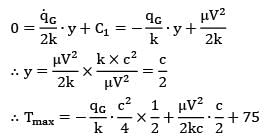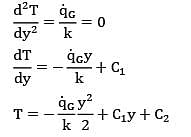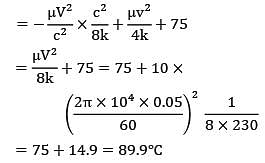Chemical Engineering Exam > Chemical Engineering Questions > An oil film acts as a lubricant (? = 10 N-s/...
Start Learning for Free
An oil film acts as a lubricant (? = 10 N-s/m2, k = 230 W/m-K,? = 1200 kg/m3) between two coaxial cylindrical surfaces (outer diameter and inner diameter = 99.5 mm). The outer cylinder rotates at . Calculate the maximum temperature in the oil film if both wall temperatures are maintained at 75°C. The rate of heat generation per unit volume due to viscous dissipation may be assumed to be  . As the oil layer is very thin ignore any convection in the layer.
. As the oil layer is very thin ignore any convection in the layer.
 . As the oil layer is very thin ignore any convection in the layer.
. As the oil layer is very thin ignore any convection in the layer.- a)89
- b)90
Correct answer is between '89,90'. Can you explain this answer?
| FREE This question is part of | Download PDF Attempt this Test |
Verified Answer
An oil film acts as a lubricant (? = 10 N-s/m2, k = 230 W/m-K,? = 120...
Since the clearance between two cylinders is very small, the velocity variation in the oil may be assumed to be linear. At any point in the oil, the heat conduction equation can be given as



View all questions of this test

Where 

At y = 0, T = 75°C, ∴ C2 = 75°C
At y = C, T = 75°C,

For maximum temperature = 



Most Upvoted Answer
An oil film acts as a lubricant (? = 10 N-s/m2, k = 230 W/m-K,? = 120...
Since the clearance between two cylinders is very small, the velocity variation in the oil may be assumed to be linear. At any point in the oil, the heat conduction equation can be given as




Where 

At y = 0, T = 75°C, ∴ C2 = 75°C
At y = C, T = 75°C,

For maximum temperature = 



Free Test
FREE
| Start Free Test |
Community Answer
An oil film acts as a lubricant (? = 10 N-s/m2, k = 230 W/m-K,? = 120...
Since the clearance between two cylinders is very small, the velocity variation in the oil may be assumed to be linear. At any point in the oil, the heat conduction equation can be given as




Where 

At y = 0, T = 75°C, ∴ C2 = 75°C
At y = C, T = 75°C,

For maximum temperature = 




|
Explore Courses for Chemical Engineering exam
|

|
Similar Chemical Engineering Doubts
An oil film acts as a lubricant (? = 10 N-s/m2, k = 230 W/m-K,? = 1200 kg/m3) between two coaxial cylindrical surfaces (outer diameter and inner diameter = 99.5 mm). The outer cylinder rotates at . Calculate the maximum temperature in the oil film if both wall temperatures are maintained at 75°C. The rate of heat generation per unit volume due to viscous dissipation may be assumed to be . As the oil layer is very thin ignore any convection in the layer.a)89b)90Correct answer is between '89,90'. Can you explain this answer?
Question Description
An oil film acts as a lubricant (? = 10 N-s/m2, k = 230 W/m-K,? = 1200 kg/m3) between two coaxial cylindrical surfaces (outer diameter and inner diameter = 99.5 mm). The outer cylinder rotates at . Calculate the maximum temperature in the oil film if both wall temperatures are maintained at 75°C. The rate of heat generation per unit volume due to viscous dissipation may be assumed to be . As the oil layer is very thin ignore any convection in the layer.a)89b)90Correct answer is between '89,90'. Can you explain this answer? for Chemical Engineering 2024 is part of Chemical Engineering preparation. The Question and answers have been prepared according to the Chemical Engineering exam syllabus. Information about An oil film acts as a lubricant (? = 10 N-s/m2, k = 230 W/m-K,? = 1200 kg/m3) between two coaxial cylindrical surfaces (outer diameter and inner diameter = 99.5 mm). The outer cylinder rotates at . Calculate the maximum temperature in the oil film if both wall temperatures are maintained at 75°C. The rate of heat generation per unit volume due to viscous dissipation may be assumed to be . As the oil layer is very thin ignore any convection in the layer.a)89b)90Correct answer is between '89,90'. Can you explain this answer? covers all topics & solutions for Chemical Engineering 2024 Exam. Find important definitions, questions, meanings, examples, exercises and tests below for An oil film acts as a lubricant (? = 10 N-s/m2, k = 230 W/m-K,? = 1200 kg/m3) between two coaxial cylindrical surfaces (outer diameter and inner diameter = 99.5 mm). The outer cylinder rotates at . Calculate the maximum temperature in the oil film if both wall temperatures are maintained at 75°C. The rate of heat generation per unit volume due to viscous dissipation may be assumed to be . As the oil layer is very thin ignore any convection in the layer.a)89b)90Correct answer is between '89,90'. Can you explain this answer?.
An oil film acts as a lubricant (? = 10 N-s/m2, k = 230 W/m-K,? = 1200 kg/m3) between two coaxial cylindrical surfaces (outer diameter and inner diameter = 99.5 mm). The outer cylinder rotates at . Calculate the maximum temperature in the oil film if both wall temperatures are maintained at 75°C. The rate of heat generation per unit volume due to viscous dissipation may be assumed to be . As the oil layer is very thin ignore any convection in the layer.a)89b)90Correct answer is between '89,90'. Can you explain this answer? for Chemical Engineering 2024 is part of Chemical Engineering preparation. The Question and answers have been prepared according to the Chemical Engineering exam syllabus. Information about An oil film acts as a lubricant (? = 10 N-s/m2, k = 230 W/m-K,? = 1200 kg/m3) between two coaxial cylindrical surfaces (outer diameter and inner diameter = 99.5 mm). The outer cylinder rotates at . Calculate the maximum temperature in the oil film if both wall temperatures are maintained at 75°C. The rate of heat generation per unit volume due to viscous dissipation may be assumed to be . As the oil layer is very thin ignore any convection in the layer.a)89b)90Correct answer is between '89,90'. Can you explain this answer? covers all topics & solutions for Chemical Engineering 2024 Exam. Find important definitions, questions, meanings, examples, exercises and tests below for An oil film acts as a lubricant (? = 10 N-s/m2, k = 230 W/m-K,? = 1200 kg/m3) between two coaxial cylindrical surfaces (outer diameter and inner diameter = 99.5 mm). The outer cylinder rotates at . Calculate the maximum temperature in the oil film if both wall temperatures are maintained at 75°C. The rate of heat generation per unit volume due to viscous dissipation may be assumed to be . As the oil layer is very thin ignore any convection in the layer.a)89b)90Correct answer is between '89,90'. Can you explain this answer?.
Solutions for An oil film acts as a lubricant (? = 10 N-s/m2, k = 230 W/m-K,? = 1200 kg/m3) between two coaxial cylindrical surfaces (outer diameter and inner diameter = 99.5 mm). The outer cylinder rotates at . Calculate the maximum temperature in the oil film if both wall temperatures are maintained at 75°C. The rate of heat generation per unit volume due to viscous dissipation may be assumed to be . As the oil layer is very thin ignore any convection in the layer.a)89b)90Correct answer is between '89,90'. Can you explain this answer? in English & in Hindi are available as part of our courses for Chemical Engineering.
Download more important topics, notes, lectures and mock test series for Chemical Engineering Exam by signing up for free.
Here you can find the meaning of An oil film acts as a lubricant (? = 10 N-s/m2, k = 230 W/m-K,? = 1200 kg/m3) between two coaxial cylindrical surfaces (outer diameter and inner diameter = 99.5 mm). The outer cylinder rotates at . Calculate the maximum temperature in the oil film if both wall temperatures are maintained at 75°C. The rate of heat generation per unit volume due to viscous dissipation may be assumed to be . As the oil layer is very thin ignore any convection in the layer.a)89b)90Correct answer is between '89,90'. Can you explain this answer? defined & explained in the simplest way possible. Besides giving the explanation of
An oil film acts as a lubricant (? = 10 N-s/m2, k = 230 W/m-K,? = 1200 kg/m3) between two coaxial cylindrical surfaces (outer diameter and inner diameter = 99.5 mm). The outer cylinder rotates at . Calculate the maximum temperature in the oil film if both wall temperatures are maintained at 75°C. The rate of heat generation per unit volume due to viscous dissipation may be assumed to be . As the oil layer is very thin ignore any convection in the layer.a)89b)90Correct answer is between '89,90'. Can you explain this answer?, a detailed solution for An oil film acts as a lubricant (? = 10 N-s/m2, k = 230 W/m-K,? = 1200 kg/m3) between two coaxial cylindrical surfaces (outer diameter and inner diameter = 99.5 mm). The outer cylinder rotates at . Calculate the maximum temperature in the oil film if both wall temperatures are maintained at 75°C. The rate of heat generation per unit volume due to viscous dissipation may be assumed to be . As the oil layer is very thin ignore any convection in the layer.a)89b)90Correct answer is between '89,90'. Can you explain this answer? has been provided alongside types of An oil film acts as a lubricant (? = 10 N-s/m2, k = 230 W/m-K,? = 1200 kg/m3) between two coaxial cylindrical surfaces (outer diameter and inner diameter = 99.5 mm). The outer cylinder rotates at . Calculate the maximum temperature in the oil film if both wall temperatures are maintained at 75°C. The rate of heat generation per unit volume due to viscous dissipation may be assumed to be . As the oil layer is very thin ignore any convection in the layer.a)89b)90Correct answer is between '89,90'. Can you explain this answer? theory, EduRev gives you an
ample number of questions to practice An oil film acts as a lubricant (? = 10 N-s/m2, k = 230 W/m-K,? = 1200 kg/m3) between two coaxial cylindrical surfaces (outer diameter and inner diameter = 99.5 mm). The outer cylinder rotates at . Calculate the maximum temperature in the oil film if both wall temperatures are maintained at 75°C. The rate of heat generation per unit volume due to viscous dissipation may be assumed to be . As the oil layer is very thin ignore any convection in the layer.a)89b)90Correct answer is between '89,90'. Can you explain this answer? tests, examples and also practice Chemical Engineering tests.

|
Explore Courses for Chemical Engineering exam
|

|
Suggested Free Tests
Signup for Free!
Signup to see your scores go up within 7 days! Learn & Practice with 1000+ FREE Notes, Videos & Tests.


















